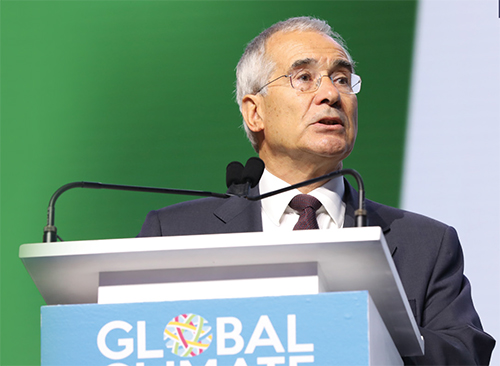Nicholas Stern highlights opportunities for boosting global economic growth ahead of IMF and World Bank meetings

Climate action around the world offers opportunities to boost global economic growth, according to extracts from a new book by Nicholas Stern, previewed ahead of the annual meetings of the International Monetary Fund and World Bank in Washington DC between 13 and 18 October.
Professor Lord Stern, who led the ‘The Economics of Climate Change: The Stern Review’ for the UK Government in 2006, has carried out an assessment of the role of climate action in driving economic growth for his new book, ‘The Growth Story of the 21st Century: The Economics and Opportunity of Climate Action’, which will be published by LSE Press on 5 November 2025, and launched at a public event at the London School of Economics and Political Science on the same day.
In the book’s chapter on ‘Rising to the challenges: the key elements of a new growth story’, Lord Stern writes: “The global economy is on an unsustainable path. The climate and biodiversity crises are now so acute that the ways in which the world produces and consumes must change rapidly, and on a great scale. We must break the destructive relationship between production and consumption on the one hand and the environment on the other.”
But he argues that “we can forge a new path for economic development that does break this destructive relationship”.
Lord Stern writes: “With the right policies and public and community action, this new path can deliver a much more attractive structure for growth and development, with rising living standards across all dimensions. It can deliver sustainable, resilient, and inclusive development. But the next two decades are critical to success.”
He points out: “The changes in economic structures and the required increase in investment and innovation are substantial and challenging. Some may argue that these changes are too difficult and ‘unrealistic’. However, the consequences of inaction far outweigh the challenges of realising the necessary investment and change needed to embark on the new path. Investment and innovation will be at the heart of the story of creating the new. That will in large measure be from the private sector. Creating the conditions and finance for that investment will be central to public action and policy.”
Lord Stern draws attention to “six driving forces arising from action to reduce emissions that together can generate a new growth story”.
- Lower costs, learning-by-doing, and induced innovation in the new cleaner technologies.
- Increasing returns to scale in new technologies.
- Greater resource efficiency across the economy.
- Stronger system productivity, including in energy, transport, cities, land, and water.
- Improved health, with associated higher productivity.
- Increase in the share of investment in overall output.
Lord Stern recognises that these six drivers of growth largely relate to climate action to reduce greenhouse gas emissions, but he also highlights the importance of adaptation and preserving nature.
He writes: “Adaptation, by building resilience to climate impacts, avoids damaging decreases in income and thus raises growth relative to output and income in its absence. See, for example, the work of the Global Commission on Adaptation (2019), which shows returns from US$1 invested in adaptation resulting in up to US$10 in net economic benefits.”
He adds: “Investments in natural capital can have powerful returns in terms of losses and disasters avoided, such as those associated with deforestation causing flooding and landslides, as hillsides are weakened and hold less water. Many such investments are vital to water systems as a whole, and thus to agriculture and health. Such investments improve development and productivity, avert disasters, and foster growth.”
But Lord Stern warns: “The magnitude of the task requires a strong jump in growth rates of investment. In the last two decades overall investment growth has not risen; in many countries, it has fallen. During the 2010s, EMDCs [emerging market and developing countries] (other than China) decreased their real investment growth rate from 9% per annum (2010) to 0.9% per annum (2019). Even including China, growth rates in EMDC investment dropped from nearly 11% (2010) to 3.4% (2019). In advanced economies, investment growth was more stable but relatively low: during 2010–2019 it remained at only around 2% per annum, similar to its long-term average. Across the world, growth in investment is still low.”
He writes: “For much of the last 15 years, there has been a global deficiency, in Keynesian terms, of planned investment relative to planned saving, as evidenced by low real interest rates (up until 2021–2022), low investment levels, and sluggish productivity growth, all alongside low inflation. The Covid-19 pandemic and the Ukraine war brought inflation and a rise in interest rates. Investment growth has remained low, and inflation is falling back. This suggests that, looking ahead over the next 15 years, as the world economy goes past these two disruptors, the global aggregate demand and supply balances could accommodate the necessary investment, potentially driving the world out of stagnation or weak growth and fostering a new kind of growth that is strong, resilient, and sustainable.”
Lord Stern also suggests that it is not yet clear “how the disruptions associated with the policies and actions of Donald Trump’s second presidency will play through”. He adds: “For some countries over the medium term, it could increase strategic investment in economic, energy, and physical security. In the short run, many investors may ‘hold off to wait and see’.”
He concludes by writing that “the new growth and development story is not just about avoiding the catastrophic consequences of climate change and biodiversity loss but about seizing the opportunity to create a better, more equitable, and sustainable world for all.”
ENDS

